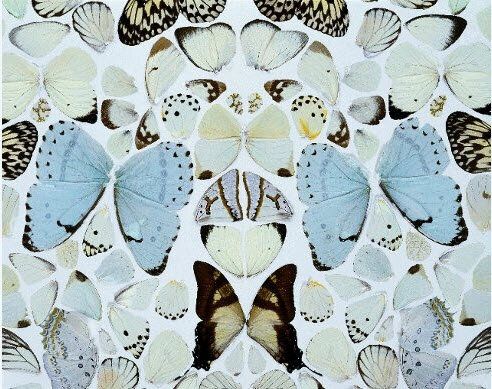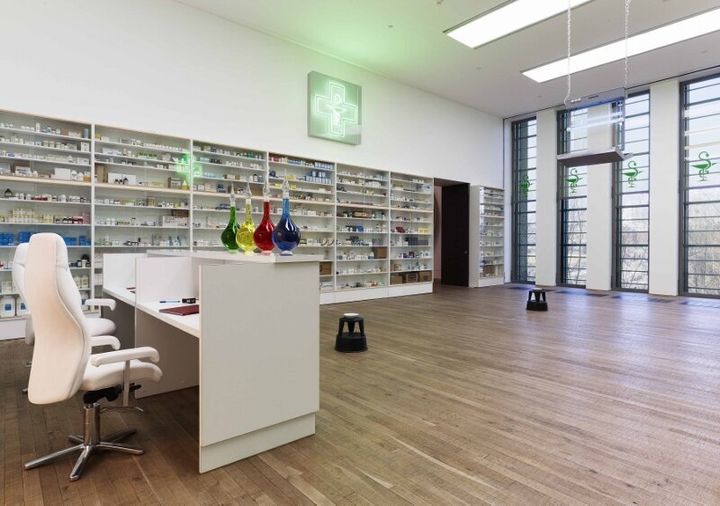Damien Hirst. The reputation loudly precedes the not-so-young British artist like some diamond encrusted Triumph of skulls, formaldehyde and sacred cows. It's a shiny, bloody and very, very expensive orgy. Hirst has earned infamy for what many saw as a ridiculously over the top sale of 218 of his works at Sotheby's in 2008. The sale, which raised over a £100 million, was happening just as the world economy was about to go into meltdown as Lehman Brother's crumbled. It seemed like materialist hubris on biblical proportions: if the world ever needed a symbol of excess it was 'Beautiful Inside My Head Forever'. The man certainly has timing, give him that.
But what about the Tate Modern's new retrospective of the artist? As has been frequently noted, Hirst is no longer quite as shocking as he once was. We've become as accustomed to works like 'Away from the Flock', Hirst's famous sheep in formaldehyde, as we have with works like Tracy Emin's notorious 'Unmade Bed'. We know, more or less, what we're going to get. Nevertheless, with Hirst there remains an undeniable raw thrill in visiting his work.

The Physical Impossibility of Death in the Mind of Someone Living 1991
Photographed by Prudence Cuming Associates
© Damien Hirst and Science Ltd. All rights reserved, DACS 2012
The most astonishing work on display here is '1000 years'. It sums Damien Hirst better than any other single work. The piece encloses a life cycle of flies in a glass vitrine: from their birth as maggots and nascent attempts at flight; to their feasting on a decaying head of a cow before being heroically fried by a light trap. Hirst's presence in this chaotic detail is minimal. Like some indifferent god, he merely lets the spectacle of life and death unfold before us. It's a piece Francis Bacon was said to have stood in front of for over an hour, and is both horrifically grotesque and utterly fascinating. The piece is epic in its scope and proportions: it's like watching one of John Martin's apocalypses unfold before your eyes; thousands of souls being born and dying every day. Life itself is put into startling grizzly perspective here in the stinking mire; more so, to my mind, than any consideration of the celestial heights.
But let's not get too carried away. With Hirst there is a joyous streak of childlike mischief running through many of his works. Indeed with works like 'Beautiful, childish, expressive, tasteless, not art, over simplistic, throw away, kids' stuff... [etc]' Hirst is clearly getting ready for the critics inevitable barbs with a bit of pre-emptive self-deprication. More often than not, Hirst revels like a child, rather than meditates like a sage, on issues of death and decay. And while '1000 years' may be a horrific consideration of life, it's a sight many under the age of ten will be able to empathise with. What imaginative child has not at least wondered if a spider or a wasp would win in a fight if trapped inside a spare jam jar? Who didn't at least attempt to flood the fragile halls of an ant nest housing thousands? Or decapitate a Barbie or two? All this is evocative of Iain Banks' masterpiece The Wasp Factory. As with Banks' work, the first reaction when confronted with this sort of horror is to laugh. Often you suspend the idea that you are in a veritable art institution with a middle aged banker's wife standing behind you, and blurt out a dark primeval delight at a severed head or a dark sun made of thousands of dead flies.

Sympathy in White Major - Absolution II 2006 (Detail)
Photographed by Prudence Cuming Associates
© Damien Hirst and Science Ltd. All rights reserved. DACS 2012.
Yet Hirst's success stems from much more than his price tags or his ability to summon up our suppressed instincts. He knows not simply what will titillate the tabloids and shock the public, but also what will get his audience thinking, and often seems to have his finger on many of the big issues of the epoch we are living through. The spectacle and spirit of science looms especially large in his works. And while universal themes are alluded to - the Holy Trinity, the ever present spectre of mortality - Hirst is aware that we are currently living in a world where flesh can now be preserved, stored and enhanced; where the gods we worship have not vanished, but merely been transplanted onto other symbols and ideas. His alter piece, for example, considers not just how much science and medicine seem to have physically come to dominate the human experience, but have spiritually and emotionally consumed us. Just as Carlyle and Turner meditated on the rapid progress of industry and mechanisation over two centuries ago, similarly does Hirst confront issues around our attitudes to science. As with Turner, this is often ambiguous: works like 'Anatomy of an Angel' could be taken as an indication of Hirst's fascination or reverence for science exhibitions but could also be seen as a critique of an overly clinical and coldly rational mindset.
As a result this exhibition confirms Hirst as more than a mere shock artist or flash in an often dull landscape of modern art. He remains relevant, provocative and intelligent.

Pharmacy 1992
Photographed by Prudence Cuming Associates
© Damien Hirst and Science Ltd. All rights reserved, DACS 2012